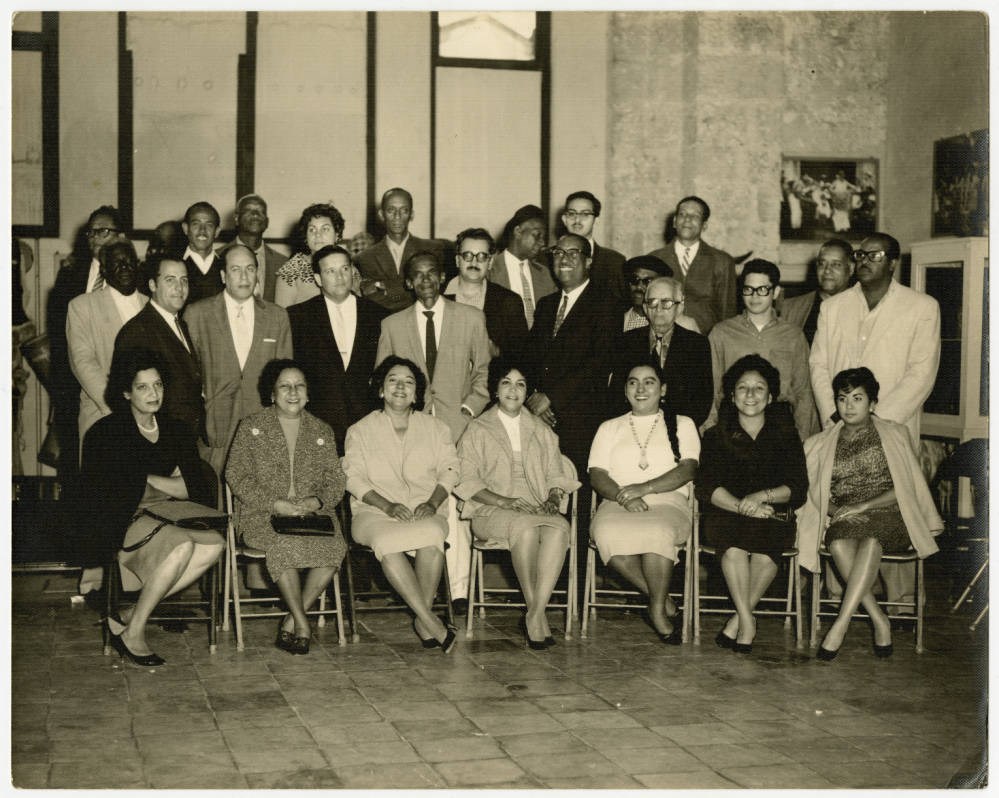Last updated: August 2, 2023
Article
Orquestas Femininas: All-Women Salsa Bands
An important part of salsa music is the bands who play the music that people sing, dance, and listen to. While a few bands might include women among their musicians, the majority of salsa bands are exclusively male. The salsa industry is dominated by men in roles from performers to producers. Like in many musical communities dominated by men, women have formed orquestas femeninas, or all-female bands, in Afro Latin music to have agency over the music they make and to express their femininity.

Courtesy of the University of Miami Library, Cuban Heritage Collection. Copyright status unknown.
Anacaona is an important orquesta feminina that originated in Cuba in the 1930s. Anacaona brought the Cuban son—the sound behind salsa—to a higher level of recognition among the Cuban elite. Recognized by the Cuban National Council of Culture in 1962, the Orquesta Anacaona was founded by Concepción "Cuchito" Castro Zaldarriaga. Chuchito brought her sisters together to form Anacaona. Her sister Alicia Castro helped the group achieve their international reputation. Anacaona has performed in the US, including several concerts in New York at the Havana-Madrid Club, NBC Radio, the Hotel Commodore, the Hotel Pierre, the Waldorf-Astoria. They have collaborated with performers such as salsera Celia Cruz and continues to record to this day with a changing group of women performers.
The most recognized orquestas femininas are Colombian. Many were based out of Cali, a city known as the world capital of salsa. During the late 1900s, the rise of salsa romántica and music education in Cali contributed to the growth of salsa in the city. One-fifth of the salsa scene in Cali were orquestas femininas between 1989 and 1995. Early on, Yemayá and Siguaraya were the first of these salsa groups in Colombia, formed around 1983 by María del Carmen Alvarado and Constanza Riveros. Along with another pioneering all-women group called Cañabrava, these women rejected the expectations of sexual femininity that men put on them and set the stage for future orquestas femininas.
Anacaona and Yemayá are both names of important women that inspired these performers. Anacaona was a female chief of the Taíno, an Indigenous people of the Caribbean, in the early 1500s. Yemayá is an orisha, or spiritual entity, that represents motherhood in Santería, an Afro Caribbean religion rooted in West African Yoruba beliefs. Siguaraya and Cañabrava are both named after strong, resistant plants used for healing. The names these bands chose to represent them illustrates that Indigenous and African beliefs were important to early all-women salsa ensembles.
Due to the rarity of all-women bands in a male-dominated scene, they quickly became commercialized. Son de Azúcar was the first commercially successful orquesta feminina from Cali. Formed in 1987, they had to change their original appearance and name (Gaviota) to fit the marketing conventions of the entertainment industry. Their success inspired other groups, such as D’Caché and Canela. These commercial bands were different from their predecessors because they were traditionally molded into feminine and racial stereotypes that would sell.
Though orquestas femininas have had different images, these ensembles gave women the opportunity to participate in a musical culture typically dominated by men. These women made way for themselves and for other women to become salsa musicians in their own communities and worldwide.
This article was researched and written by Hermán Luis Chávez, NCPE Intern, Cultural Resources Office of Interpretation and Education.
Castro, Alicia, Kummels, Ingrid, and Schäfer, Manfred. Queens of Havana: The Amazing Adventures of Anacaona, Cuba's Legendary All-Girl Dance Band. New York: Grove/Atlantic, 2007.
Poey, Delia. “To the Beat of Their Own Drum: Women in Salsa.” Complutense Journal of English Studies 23 (2015): 69.
Sanmiguel, Alejandro Ulloa. “Identity Is Also Danced (Cali, Colombia).” In Salsa World: A Global Dance in Local Contexts, edited by Sydney Hutchinson, 140–56. Temple University Press, 2014.
Valverde, Umberto and Raphael Quintero. Abran Paso: Historia de las orquestasfe- meninas de Cali. Cali: Ediciones Universidad del Valle, 1995.
Waxer, Lise. “Las Caleñas Son Como Las Flores: The Rise of All-Women Salsa Bands in Cali, Colombia.” Ethnomusicology 45, no. 2 (2001): 228–259.
Tags
- salsa
- music
- music history
- oiste
- latino history
- latino
- latino heritage
- pathways through salsa
- women's history
- gender
- women and the arts
- women and culture
- arts culture and education
- us in the world community
- women in the world community
- afro latino
- cuba
- cuban
- cuban american history
- colombia
- colombian
- colombian american
